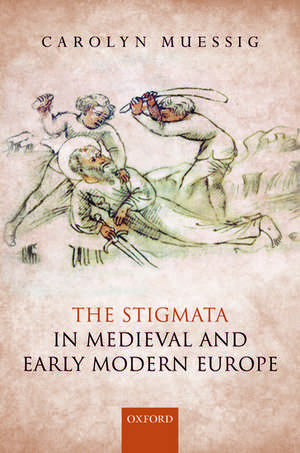The Stigmata in Medieval and Early Modern Europe
Autor Carolyn Muessigen Limba Engleză Hardback – 6 feb 2020
Preț: 644.41 lei
Preț vechi: 859.81 lei
-25% Nou
Puncte Express: 967
Preț estimativ în valută:
123.30€ • 128.74$ • 102.05£
123.30€ • 128.74$ • 102.05£
Carte disponibilă
Livrare economică 03-10 martie
Preluare comenzi: 021 569.72.76
Specificații
ISBN-13: 9780198795643
ISBN-10: 0198795645
Pagini: 308
Ilustrații: 22 Half-tones
Dimensiuni: 165 x 240 x 27 mm
Greutate: 0.64 kg
Editura: OUP OXFORD
Colecția OUP Oxford
Locul publicării:Oxford, United Kingdom
ISBN-10: 0198795645
Pagini: 308
Ilustrații: 22 Half-tones
Dimensiuni: 165 x 240 x 27 mm
Greutate: 0.64 kg
Editura: OUP OXFORD
Colecția OUP Oxford
Locul publicării:Oxford, United Kingdom
Recenzii
Muessig's contribution stands-and I believe will continue to stand for a long time to come-as the seminal work on medieval and early-modern stigmatization.
Muessig's study is an important contribution to the field of medieval studies, as well as the wider historiographies of gender, theology, religious devotion, and visual/ material culture. It provides a comprehensive re-evaluation of stigmatology from a range of perspectives, which brings potentially one of the most baffling (for modern eyes) phenomena of the Middle Ages in line with beliefs and practices concerning the body, mind and soul, female and lay devotion, and human relationships with the divine.
Carolyn Muessig's latest book is a long-awaited cultural history of the stigmata and stigmatization in the West
Her analysis is admirably clear and amply illustrated with primary sources: saints' lives, theological and spiritual treatises, sermons, and visual images. It will serve as a rich source for further scholarly inquiry not only on stigmata itself but also on the many important issues raised in connection with it. In short, The Stigmata in Medieval and Early Modern Europe is an essential book for scholars and students of premodern religion.
This is a field-defining work. Muessig puts medieval devotion into context in material and visual culture, highlights cultural meaning as the backdrop for theological formulation, and traces the evolution of one of Western Christianity's most bizarre phenomena, and does so in an accessible way. She documents her sources meticulously, includes multiple images per chapter, and provides a comprehensive history in a relatively compact volume. This is a must-read for students of medieval theology and mysticism, the history of religion and gender, and historical devotional practice.
an important contribution to the field of medieval studies
Overall, this is an excellent study that deals with so many essential religious, sacramental, sociological, political, and gender issues ... Muessig should be congratulated because of her abundant use of so many primary sources in dealing with the issue of the stigmata ... It is very difficult to capture in a book review the richness of this most valuable piece of scholarship!
Muessig's study is an important contribution to the field of medieval studies, as well as the wider historiographies of gender, theology, religious devotion, and visual/ material culture. It provides a comprehensive re-evaluation of stigmatology from a range of perspectives, which brings potentially one of the most baffling (for modern eyes) phenomena of the Middle Ages in line with beliefs and practices concerning the body, mind and soul, female and lay devotion, and human relationships with the divine.
Carolyn Muessig's latest book is a long-awaited cultural history of the stigmata and stigmatization in the West
Her analysis is admirably clear and amply illustrated with primary sources: saints' lives, theological and spiritual treatises, sermons, and visual images. It will serve as a rich source for further scholarly inquiry not only on stigmata itself but also on the many important issues raised in connection with it. In short, The Stigmata in Medieval and Early Modern Europe is an essential book for scholars and students of premodern religion.
This is a field-defining work. Muessig puts medieval devotion into context in material and visual culture, highlights cultural meaning as the backdrop for theological formulation, and traces the evolution of one of Western Christianity's most bizarre phenomena, and does so in an accessible way. She documents her sources meticulously, includes multiple images per chapter, and provides a comprehensive history in a relatively compact volume. This is a must-read for students of medieval theology and mysticism, the history of religion and gender, and historical devotional practice.
an important contribution to the field of medieval studies
Overall, this is an excellent study that deals with so many essential religious, sacramental, sociological, political, and gender issues ... Muessig should be congratulated because of her abundant use of so many primary sources in dealing with the issue of the stigmata ... It is very difficult to capture in a book review the richness of this most valuable piece of scholarship!
Notă biografică
Carolyn Muessig is Professor of Medieval Religion and Co-Director at the Centre for Medieval Studies at the University of Bristol. She is a medievalist, specializing on the devotional practices and beliefs of late medieval Europe. Her interest in this area began during her studies for a BA in History from the State University of New York at Buffalo. Since 2001 she has been series co-editor (with George Ferzoco) of Routledge Studies in Medieval Religion and Culture. Her publications include A Companion to Catherine of Siena (co-edited with George Ferzoco and Beverly Mayne Kienzle; 2011), Envisaging Heaven in the Middle Age (co-edited with Ad Putter; 2007), and The Faces of Women in the Sermons of Jacques de Vitry (1999).
